Watch tutorials, webinars and informative videos about PreSens optical sensor systems.
Subsurface Oxygen Availability Controls Greenhouse Gas Emission From Wetland Ecosystems
Christian Juncher Jørgensen & Bo Elberling
Department of Geography and Geology, University of Copenhagen, Denmark
Oxygen (O2) is one of the primary controls on the biogeochemistry of wetland soils. Its availability regulates both the production and consumption of important greenhouse gases such as carbon dioxide (CO2), methane (CH4), and nitrous oxide (N2O) in the soil, and thereby potential emission of these gases to the atmosphere. The application of chemical optical sensors (Dipping Probe DP-PSt3) connected to a multi-channel oxygen meter (OXY-10 mini) by PreSens enabled reliable, long term measurements in different soil depths in a Danish wetland. Results revealed complex interactions between daily and seasonal changes in O2 and mineral nitrogen availability.
In wetland soil the O2 availability is often limited by high soil water contents and the position of the water table. As Northern wetlands store about 30 % of the global subsurface organic carbon (C) pools and function as net sources of these important greenhouse gases, detailed knowledge on the O2 availability and O2 dynamics in the soil is crucial for understanding both current greenhouse gas producing and consuming processes and net emissions to the atmosphere, as well as for predicting future changes in net emissions from the soil to the atmosphere. Until recently, knowledge on the greenhouse gas regulating effect of O2 on the field scale has been obtained from isolated laboratory experiments. We have seen that the transport of soil gases across the soil-atmosphere interface occurs both via diffusive transport in air-filled pore space in the soil as well as through the aerenchymous tissue of many wetland plants. However, one of the key missing factors for understanding the processes on a real-life ecosystem scale has been the lack of continuous high-resolution non-intrusive measurements of subsurface O2 availability in wetland soil at contrasting environmental conditions due to a fluctuating water table and seasonal growth of subsurface aerating wetland macrophytes.
Oxygen Measurement with Chemical Optical Sensors
At the University of Copenhagen, Department of Geography and Geology, we have targeted these important issues of obtaining continuous field-scale measurements of the subsurface O2 dynamics (Fig. 1) by using O2 dipping probes (type PSt3, PreSens GmbH). The sensors were permanently installed in a soil profile at 5, 10, 15, 20, 25, 30, 35, 40, 45, 50, and 60 cm depth below the surface and connected to a multi-channel oxygen meter (OXY-10 mini, PreSens GmbH) connected to a microcontroller (CR1000 data logger, Campbell Scientific) for automated data collection. Prior to permanent installation in the soil profile, the oxygen probes were calibrated in oxygen-free (0 % atm. saturation) and oxygen-saturated water (100 % atm. saturation). Raw phase angle outputs were converted into temperature corrected O2 concentrations (% atm. saturation) using soil temperature values measured at the respective depths. The use of these oxygen probes allowed continuous and maintenance free measurements of the field-scale O2 dynamics at a temporal resolution of 10 minutes over a period of two years with excellent reliability and virtually no missing measurements.

Results
Results from our investigations reveal that the subsurface greenhouse gas production, consumption and emission dynamics are controlled by a number of complex interactions between daily and seasonal changes in O2 and mineral nitrogen availability following near-surface water table fluctuations and diurnal variation in incoming light (Fig. 2), all in all highlighting the importance of ecosystem dependent soil-plant-atmosphere interactions.
Wetland References:
[1] Askaer, L., Elberling, B., Glud, R. N., Kühl, M., Lauritsen, F. R., Joensen, H. P., 2010. Soil heterogeneity effects on O2 distribution and CH4 emissions from wetlands: In situ and mesocosm studies with planar O2 optodes and membrane inlet mass spectometry. Soil biology and Biochemistery 42, 2254 - 2265
[2] Elberling, B., Askaer, L., Jørgensen, C. J., Joensen, H. P., Kühl, M. Glud, R. N., Lauritsen, F. R., 2011. Linking soil O2, CO2 and CH4 concentrations in a wetland soil: implications for CO2 and CH4 fluxes. Environmental Science & Technology 45, 3393 - 339
[3] Jørgensen, C. J., Struwe, S., Elberling B., 2012. Temporal treands in N20 flux dynamics in a Danish wetland - effects of plant-mediated gas transport of N2O and O2 following changes in water level and soil mineral-N availability. Global Change Biology 18, 210 - 222.
Other Applications:
[4] Elberling B., Matthiesen, H., Jørgensen, C. J., Hansen, B. U., Grønnow, B., Meldgaard, M., Andreasen, C., Khan, S. A., 2011. Paleo-Eskimo kitchen midden preservation in permafrost under future climate conditions at Qajaa, West Greenland. Journal of Archaeological Science 38, 1331 - 1339



